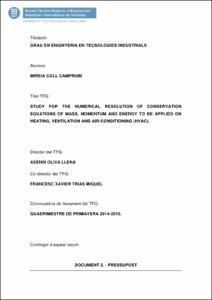Mostra el registre d'ítem simple
Study for the numerical resolution of conservation equations of mass, momentum and energy to be applied on heating, ventilation and air-conditioning (HVAC)
| dc.contributor | Oliva Llena, Asensio |
| dc.contributor | Trias Miquel, Francesc Xavier |
| dc.contributor.author | Coll Camprubí, Mireia |
| dc.contributor.other | Universitat Politècnica de Catalunya. Departament de Màquines i Motors Tèrmics |
| dc.date.accessioned | 2015-10-20T11:26:24Z |
| dc.date.available | 2015-10-20T11:26:24Z |
| dc.date.issued | 2015 |
| dc.identifier.uri | http://hdl.handle.net/2117/77956 |
| dc.description.abstract | The study consist, as its name says, in the resolution of the Navier-Stokes equations applied to solving concrete engineering cases. Going into more detail, this study is divided in three basic parts. The first consist in the explanation of the involved theory that is behind the implementation of a code that solves a CFD&HT problem, as well as the numerical methods and the physics involved. In the second part of the study, is where is entered in detail on the resolution of four concrete cases. Those four practical cases have been develop in order to learn and accomplish the knowledge needed to be able to solve cases more closer to the real engineering applications. And at the same time, to verify that the implemented codes are correct, while comparing the obtained result with the benchmark ones. Finally, in the third part is entered in the detail of solving a concrete case of a propriety engineering application. This case consists in studying the air conditioning behaviour of a room (HVAC&R), through programing the code and analysing the obtained results |
| dc.description.abstract | El treball consisteix, tal com diu el seu nom, en la resolució de les equacions de Naveir-Stokes aplicades a solucionar casos concrets d’enginyeria. Entrant més en detall, el treball es divideix en tres parts bàsiques. La primer consisteix en l’explicació de tota la teoria que hi ha darrera la implementació d’un codi que solucioni un roblema de CFD&HT, així com els mètodes numèrics i la física involucrada. En la segona part del treball, és on s’entra en detall en la resolució de quatre casos concrets. Aquests quatre casos pràctics s’han realitzat amb l’objectiu d’aprendre i assolir els coneixements necessaris per poder resoldre casos més propers a una aplicació real d’enginyeria. I alhora, per verificar que els codis implementats són correctes, mitjançant la comparació dels resultats obtinguts amb els de referència. Finalment, en la tercera part s’entra en detall a resoldre un cas concret d’aplicació pròpiament d’enginyeria. Aquest cas consisteix en estudiar la climatització d’una habitació, tot programant el codi i analitzant els resultats obtinguts |
| dc.language.iso | eng |
| dc.publisher | Universitat Politècnica de Catalunya |
| dc.rights | Attribution-NonCommercial-NoDerivs 3.0 Spain |
| dc.rights.uri | http://creativecommons.org/licenses/by-nc-nd/3.0/es/ |
| dc.subject | Àrees temàtiques de la UPC::Matemàtiques i estadística::Equacions diferencials i integrals::Equacions en derivades parcials |
| dc.subject | Àrees temàtiques de la UPC::Edificació::Instal·lacions i acondicionament d'edificis::Instal·lacions de climatització |
| dc.subject.lcsh | Navier-Stokes equations |
| dc.subject.lcsh | Air conditioning--Efficiency |
| dc.title | Study for the numerical resolution of conservation equations of mass, momentum and energy to be applied on heating, ventilation and air-conditioning (HVAC) |
| dc.type | Bachelor thesis |
| dc.subject.lemac | Equacions de Navier-Stokes |
| dc.subject.lemac | Aire condicionat -- Consum d'energia |
| dc.rights.access | Open Access |
| dc.audience.educationlevel | Grau |
| dc.audience.mediator | Escola Tècnica Superior d'Enginyeries Industrial i Aeronàutica de Terrassa |
| dc.audience.degree | GRAU EN ENGINYERIA EN TECNOLOGIES INDUSTRIALS (Pla 2010) |




